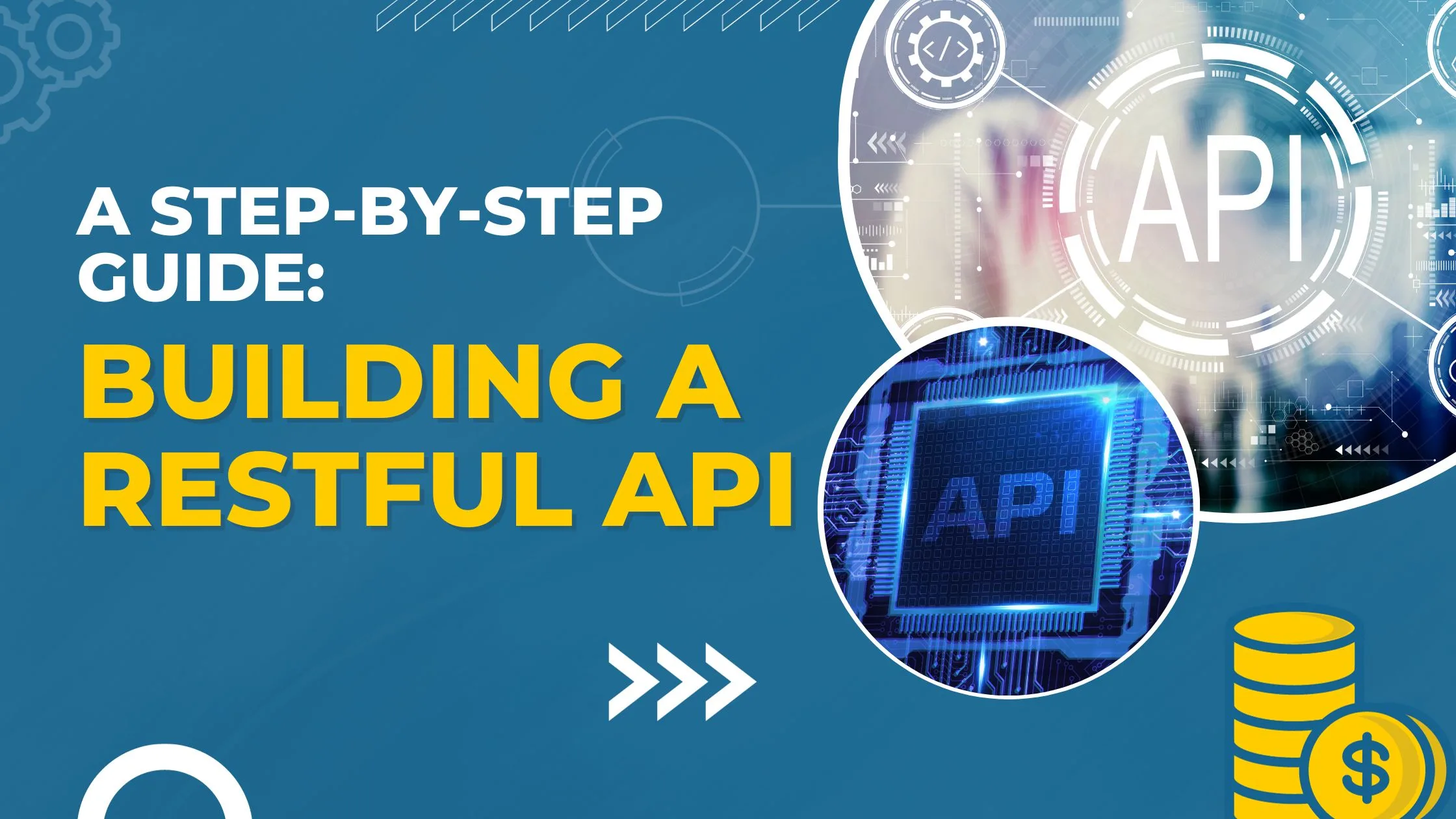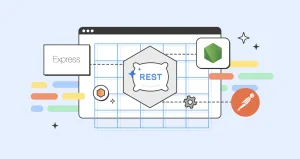Building a RESTful API: A Step-by-Step Guide
Are you ready to dive into the world of RESTful APIs and unlock a whole new level of seamless communication between your applications? Look no further, because we have got you covered! In this step-by-step guide, we will take you on an exciting journey of building a powerful RESTful API from scratch.
Whether you are a seasoned developer or just starting out, get ready to unravel the secrets behind creating robust APIs that effortlessly connect your systems and unleash their true potential. So fasten your seatbelts as we embark on this adventure together – let’s build something extraordinary!
What is a RESTful API?
A RESTful API, or Representational State Transfer Application Programming Interface, is an architectural style for designing and interacting with web services. It was first introduced by Roy Fielding in 2000 as part of his doctoral dissertation and has since become the most commonly used framework for building APIs.
The main goal of a RESTful API is to provide a standard way for different systems to communicate with each other over the internet. This allows developers to create more dynamic and flexible applications by leveraging existing resources and functionality from other systems.
At its core, a RESTful API uses HTTP requests to perform operations on data. These requests are made up of four main components: the endpoint, the method, the headers, and the body.
1. Endpoint:
An endpoint is a specific URL that represents a resource or collection of resources on a server. For example, https://api.example.com/v1/users could be an endpoint that retrieves user information from version 1 of an API.
2. Method:
There are several methods used in RESTful APIs, but the most common ones are GET (to retrieve data), POST (to create new data), PUT/PATCH (to update existing data), and DELETE (to remove data). The method chosen depends on what you want to do with the resource at the specified endpoint.
3. Headers:
Headers contain additional information about the request such as authorization tokens or content type. They provide crucial context for how the server should handle incoming requests.
4. Body:
The body of a request contains any data that needs to be sent to the server, such as parameters for creating or updating a resource.
In addition to these components, a RESTful API also follows a set of architectural principles known as the Richardson Maturity Model. This model outlines different levels of maturity for APIs, from level 0 (no adherence to REST principles) to level 3 (full adherence to REST principles).
Benefits of Using RESTful APIs
RESTful APIs (Representational State Transfer) have become the standard for building web services and are widely used by developers and companies of all sizes. This is due to their numerous benefits, which make them a preferred choice over other types of APIs. In this section, we will delve into the various advantages of using RESTful APIs.
1. Scalability:
One of the main benefits of using RESTful APIs is its scalability. With the increasing demand for web services, it has become crucial for APIs to be able to handle a large number of requests without compromising on performance. RESTful APIs excel in this aspect as they follow a stateless client-server architecture, where each request contains all the necessary information for the server to process it. This makes scaling much easier as additional resources can be added to handle an increased load without having to worry about maintaining session states or tracking user sessions.
2. Simplicity:
Another significant benefit of RESTful APIs is their simplicity in design and implementation. The principles and constraints followed by REST make it easy for developers to understand and work with these APIs, even if they are not familiar with them before. Its use of standardized HTTP methods such as GET, POST, PUT, DELETE makes it easy to build and maintain applications that interact with the API.
3. Flexibility:
RESTful APIs offer a high degree of flexibility when it comes to data formats and protocols used for communication between clients and servers. Unlike other types of APIs that may require specific data formats or protocols, RESTful APIs can support a variety of formats such as JSON, XML, and others. This flexibility allows developers to choose the most suitable format for their application and makes it easier to integrate the API with other systems.
4. Portability:
Since RESTful APIs use HTTP as their underlying protocol, they can be accessed from any platform or device that supports the protocol. This makes them highly portable and allows for cross-platform development. Developers can build applications for different platforms using the same API, reducing development time and costs.
5. Better Performance:
RESTful APIs are known for their high performance due to their statelessness and cacheability features. By eliminating the need to maintain session states, these APIs reduce server overhead, leading to faster response times. Moreover, caching responses allows for efficient use of network resources and reduces the number of requests sent to the server, further improving performance.
6. Easy Integration:
Another significant advantage of using RESTful APIs is their ease of integration with other systems and services. As long as both parties follow the same architectural principles and data formats, integrating an API into an existing system becomes a straightforward process.
Understanding HTTP Requests and Responses
HTTP (Hypertext Transfer Protocol) is the fundamental protocol used for communication between a client and server on the internet. It allows for the transfer of data, such as text, images, videos, and other media between devices. When building a RESTful API, it is essential to understand how HTTP requests and responses work to ensure efficient communication between your API and its clients.
In this section, we will dive into the details of HTTP requests and responses and discuss their structure, methods, headers, status codes, and more.
Structure of HTTP Requests:
HTTP requests consist of three main components: Request line, Headers, and Body.
1. Request Line:
The request line contains the method being used for the request (GET/POST/PUT/DELETE), followed by the resource path or endpoint that is being requested. For example – GET /users would indicate a GET request to retrieve all users from an API.
2. Headers:
Headers provide additional information about the request such as content type (application/json), authorization credentials (API key/token), cookies, cache-control directives, etc. These headers are essential for both security purposes and providing instructions to servers on how to handle the request.
Setting up Your Development Environment
Before diving into building a RESTful API, it is important to set up your development environment. This involves installing the necessary tools and packages that will help you efficiently create and test your API. In this section, we will walk you through the steps of setting up a development environment for building your RESTful API.
Step 1: Choose Your Preferred Programming Language
The first step in setting up your development environment is to choose the programming language you want to use for building your RESTful API. Some popular options include Python, Java, Node.js, and Ruby. Each has its own unique features and benefits, so it’s recommended to choose one that you are comfortable with or have experience in.
Step 2: Install a Code Editor
A code editor is an essential tool for writing code. It provides helpful features such as syntax highlighting, autocomplete, and debugging tools that make coding easier and faster. There are many code editors available such as Visual Studio Code, Atom, Sublime Text, or IntelliJ IDEA. Choose one that suits your needs and install it on your computer.
Step 3: Set Up Version Control System
Using a version control system (VCS) is crucial when working on any software project. It allows developers to track changes made to the codebase over time, collaborate with others seamlessly, and revert back to previous versions if needed. Git is the most popular VCS used by developers worldwide; however, there are other options like Mercurial and SVN. Choose a VCS that you are comfortable with and install it on your computer.
Step 4: Install Package Manager
A package manager is a tool that helps you install, update, and manage dependencies for your project. It streamlines the process of adding external libraries or modules to your codebase, making it easier to maintain and share your code with others. Depending on the programming language you have chosen, there are different package managers available such as pip for Python, npm for Node.js, Maven for Java, or Bundler for Ruby.
Step 5: Set Up a Database
Most RESTful APIs require some form of database to store and retrieve data. Depending on the requirements of your API, you can choose from SQL databases like MySQL or PostgreSQL or NoSQL databases like MongoDB or Redis. Install the database of your choice on your computer and familiarize yourself with its basic commands and operations.
Planning Your API Structure and Endpoints
Before diving into the actual development of your RESTful API, it is important to plan out its structure and endpoints. By having a clear understanding of how your API will be organized and what endpoints will be available, you can ensure that your API is well-organized, efficient, and easy to use.
1. Define Your Resources
The first step in planning your API structure is to define the resources that will be accessible through your API. Resources are essentially the data or objects that your API will allow users to interact with. For example, if you are building an e-commerce API, some of your resources may include products, orders, customers, and payments.
It is important to carefully consider which resources are necessary for your application and how they relate to each other. This will help you determine the best way to organize them in your API structure.
2. Choose a Logical Hierarchy
Once you have identified all the resources for your API, the next step is to determine a logical hierarchy for organizing them. This involves deciding which resources should be nested within others and how they should be related.
A common approach is to use a parent-child relationship between resources where the child resource represents a part or subset of the parent resource. For example, in an e-commerce API, orders would typically be nested under customers since each customer can have multiple orders associated with them.
When building a RESTful API, it is important to carefully plan the structure and endpoints in order to create a well-organized and efficient system. This will not only make it easier for developers to understand and use the API, but also ensure that it can easily scale as your application grows.
Writing Code for Your API Endpoints
Writing code for your API endpoints is a crucial step in building a RESTful API. These endpoints serve as the bridge between your application and the outside world, allowing users to interact with your API and retrieve or modify data. In this section, we will cover the key aspects of writing code for your API endpoints, including choosing an appropriate programming language, designing your endpoint URLs, handling HTTP requests and responses, and implementing CRUD operations.
1. Choosing a Programming Language:
The first decision you need to make when writing code for your API endpoints is choosing a programming language. The most popular languages used for building APIs are Java, Python, PHP, and Node.js. Each language has its own strengths and weaknesses and ultimately depends on the specific requirements of your project. However, it is important to choose a language that is widely supported by developers and has robust frameworks available for building APIs.
2. Designing Endpoint URLs:
Once you have decided on a programming language, the next step is to design your endpoint URLs. These URLs will be used by clients to make requests to your API and should follow RESTful conventions. A good practice is to use nouns instead of verbs in your URL structure, which makes them more intuitive and easier to understand. For example, if you have an endpoint that retrieves user information, it could be structured as /users/{user_id}.
Testing and Debugging Your API
Testing and debugging are crucial steps in the process of building a RESTful API. It is important to ensure that your API functions as intended and any errors or bugs are identified and fixed before it is deployed for use by clients. In this section, we will discuss some best practices for testing and debugging your API.
1. Unit Testing:
Unit testing involves testing individual units or components of code to ensure they function correctly. This type of testing is particularly useful for APIs as they consist of multiple endpoints that can be tested individually. By writing unit tests, you can check the response received from each endpoint and ensure it meets the expected results.
To perform unit testing on your API, you can use tools like Postman or Insomnia that allow you to make HTTP requests and validate the responses. You can also write automated tests using frameworks like Jest or Mocha.
2. Integration Testing:
Integration testing involves testing how different components of your API work together. This type of testing helps identify any integration issues that may arise when different modules interact with each other.
One way to perform integration testing is by using a tool called Newman, which allows you to automate Postman collections containing multiple requests. Newman executes these requests one after another, simulating real-world usage scenarios, and reports any errors encountered during execution.
Securing Your API with Authentication and Authorization
Securing your API with authentication and authorization is a crucial step in building a RESTful API. It ensures that only authorized users have access to your API’s resources, protecting sensitive data and preventing unauthorized actions.
Authentication is the process of verifying the identity of a user or application accessing the API. This can be achieved through various methods such as tokens, basic authentication, OAuth, or JSON Web Tokens (JWT). Each method has its own pros and cons, but the most secure and commonly used method for authentication in RESTful APIs is JWT.
JWTs are self-contained tokens that contain information about the user’s identity and are encrypted using a secret key. When a user attempts to access an endpoint on your API, they must provide their JWT token along with their request. The server then decrypts the token using the secret key and verifies its authenticity before allowing access to the requested resource.
Authorization, on the other hand, is the process of determining whether an authenticated user has permission to perform a specific action on a particular resource. It goes beyond just verifying identity and also checks for proper permissions based on roles or scopes assigned to each user.
There are several ways to implement authorization in your RESTful API. One common approach is role-based authorization, where users are assigned specific roles (e.g., admin, editor, viewer) with different levels of access to resources. Another approach is scope-based authorization, where permissions are granted based on specific actions or operations (e.g., read-only access).
Documenting Your API for Others to Use
Once you have built your RESTful API, it is important to document it properly so that others can easily understand and use it. Documentation provides essential information about your API’s endpoints, parameters, responses, and authentication methods. It is a crucial aspect of building a successful and user-friendly API.
In this section, we will discuss the importance of documenting your API and provide some helpful tips on how to create effective documentation.
Why Document Your API?
1. For better understanding: Good documentation helps users understand your API without having to dig through the code. It provides clear explanations of each endpoint, its purpose, and how to use it.
2. Attract developers: Well-documented APIs are more likely to attract developers who are looking for an easy-to-use and well-maintained solution for their projects.
3. Reduce support requests: By providing thorough documentation, you can reduce the number of support requests from users who struggle with using your API.
4. Facilitate integration: Documentation makes it easier for developers to integrate your API into their applications by providing clear instructions on how to make requests and handle responses.
Best Practices for Designing and Building a RESTful API
When it comes to designing and building a RESTful API, there are certain best practices that should be followed in order to ensure its effectiveness, scalability, and maintainability. In this section, we will discuss some of the key best practices that you should consider while developing your RESTful API.
1. Follow REST Principles:
The first and most important aspect of designing a RESTful API is to adhere to the principles of REST (Representational State Transfer). These principles include using HTTP methods correctly, having a uniform resource identifier (URI) structure, being stateless, providing self-descriptive messages through hypermedia links, and using cache control effectively. By following these principles, you can ensure that your API is truly RESTful and easily understood by developers.
2. Use Proper Naming Conventions:
It is essential to use consistent naming conventions for resources and endpoints in your API. This helps in making your API more intuitive for developers who are consuming it. You can also follow standard naming conventions such as using nouns instead of verbs for resources and pluralizing them when necessary.
3. Version Your API:
As your API evolves over time with new features or changes being made, it’s crucial to version it so that existing clients don’t break due to changes. Versioning allows you to make updates without affecting existing users while also giving them the option to upgrade to newer versions when they are ready.
Conclusion
Building a RESTful API may seem like a daunting task, but by following these step-by-step instructions and understanding the key principles of REST architecture, you can create a powerful and efficient API for your application. Remember to keep it simple, scalable, and secure. With proper planning and implementation, your RESTful API will not only enhance user experience but also make your development process smoother. So go ahead and start building your own RESTful API today!





